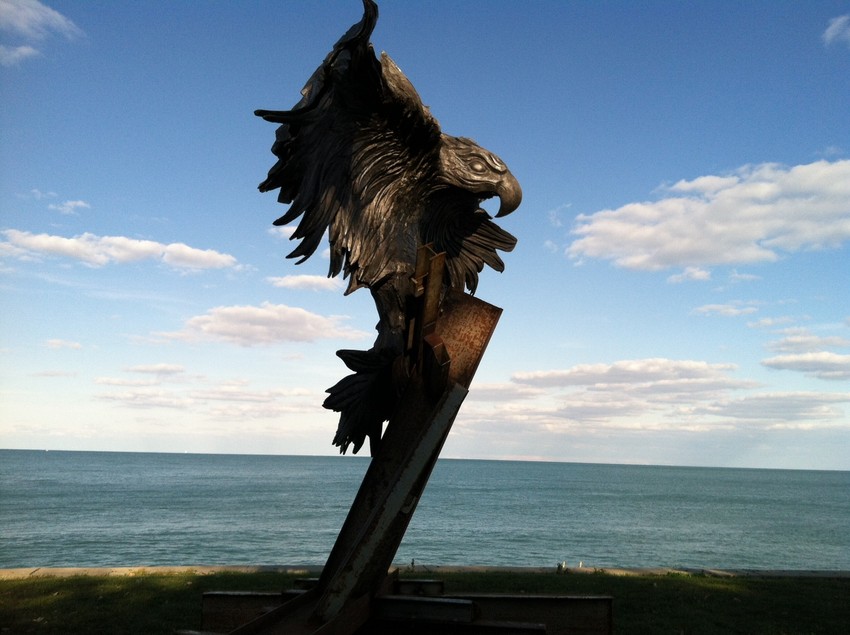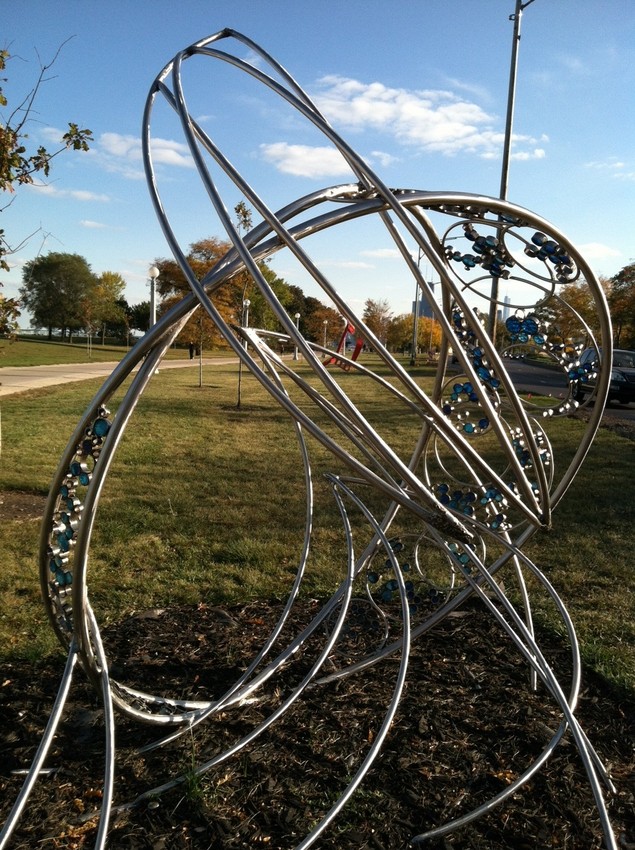Lakefront sculpture: Is mediocre art obstructing a beautiful view?
By Alison Cuddy

Lakefront sculpture: Is mediocre art obstructing a beautiful view?
By Alison Cuddy
New sculptural exhibitions have recently opened in Pilsen storefronts and on the parks and streets of some North Side neighborhoods. But the most visible collection can be found along Chicago’s lakefront: 53 works lining the stretch between the Museum Campus on the south and Lakeview on the north.
The works are varied, both literal and conceptual, and made out of stone, metal and wood. But reaction to them, at least through my informal and completely unscientific survey of friends and acquaintances, was universal: Not good. Ugly. Obstructions impeding the beautiful lake view.
I have to admit, I was more than sympathetic to this perspective. Every night as my bus crawled past the large red work resembling an elongated grasshopper, the confusing cluster of silver festooned with blue ornaments, the strange wooden billboard whose message I could not decipher, I’d think: Why?

Not so this sudden sculptural onslaught of giant eagles and rusting hulks of metal. Still, I decided to get off my high horse (or bus) and see what those passing by thought.
Chicagoan Pam MacNamara described the work Chicago Industrial as “menacing, and not pretty.” Joshua Worthington from Louisville, Ky., thought Brushy Mountain should be renamed the “hurt locker” (a reference to the war film by Kathyrn Bigelow) and wondered if it had been “put out for Halloween.” Jennifer Cook, who has lived in the area for 25 years, said the same piece looked like an “outhouse.” Then, noting that park facilities were closed for the season, Cook laughed and said, “Good lord, I hope nobody tries to use it!”
Their varied reactions came as no surprise to Anna Cerniglia, who directs the local art gallery Johalla Projects and has served on public art selection committees.
“I don’t really see this project as being cohesive,” Cerniglia said. “I see this as a big selection. Lots of artist submitted their work and then it was juried, which might be why people have a bad reflection on this. Because nothing really goes together, but it’s expected to go together.”
The exhibition was put together by Chicago Sculpture International (CSI) and draws on existing work by members of affiliate groups of sculptors. It was juried by well-known Chicago sculptor Richard Hunt and the Chicago Park District’s Adam Schwerner. Schwerner’s also the guy who had the idea to paint some of the park’s dying trees - to turn them temporarily into sculptural objects (a cluster near the Lincoln Park rowing basin will come down later this fall).

When I asked why they put them on the lakefront, Schwerner said it was about access: Someone could ride the bike path and discover the works in a linear way and in one outing. That decision wasn’t subject to public approval or input.
CSI funded the project (installation, removal and any damage to the park) and so, as Schwerner put it, the Park District was “somewhat reliant on what their desires were to do this.” That also explains why initially there were no sculptures on the south stretch of the bike path. But the Park District had a “conversation” with the organizers about re-thinking that decision, Schwerner says, because both the Park District and community members wanted to see that happen. CSI is now installing about a dozen more sculptures south of the Museum Campus.
Schwerner said otherwise, reaction to the sculptures has been “almost entirely positive.” A few people complained about having more sculpture in green, open spaces. And even Schwerner admitted to liking some works better than others. But he was firm in saying that this is the wave of the future at the Park District.
“The Chicago Cultural Plan talks to wanting to have arts and culture out in the parks and throughout the city, and we want to encourage that. So this is just the beginning,” he said.
That’s something all of the people I spoke with will welcome. Pam McNamara enthused, “I think the whole idea of doing the whole public art works is great. And I’m sure there’ll be many that I think will be wonderful.” And Cole Hainz said as long as they’re not obstrusive, he welcomed the work as a “little surprise” along his walk.
In that sense the exhibition has met Schwerner’s expectations, which is to see it as an invitation of sorts, something he hopes will attract varied responses.
So here are my questions: If the Park District plans future partnerships with CSI or other private cultural organizations, will they invite public input? These works were put in place primarily to draw attention to the recent International Sculpture Center Conference, but Chicagoans will be living with them a lot longer. Schwerner emphasized multiple times that the exhibition didn’t cost taxpayers anything, although a handful of aldermen and some local businesses provided sponsorship. But does that preclude public participation in determining how much and what kind of culture takes place on land that belongs not to a private entity but to the citizens of Chicago?
What do you think – of the sculptures themselves, and of the Park District’s plans to do more of these exhibitions in the parks? Check out a slideshow of all the images here - then I welcome your comments!


